This is an old revision of this page, as edited by Walter J. Rotelmayer (talk | contribs) at 01:19, 27 October 2012. The present address (URL) is a permanent link to this revision, which may differ significantly from the current revision.
Revision as of 01:19, 27 October 2012 by Walter J. Rotelmayer (talk | contribs)(diff) ← Previous revision | Latest revision (diff) | Newer revision → (diff) This article is about the explorer. For other uses, see Christopher Columbus (disambiguation).| Christopher Columbus | |
|---|---|
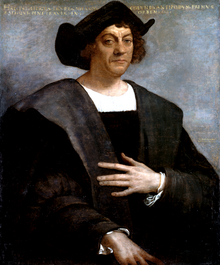 Posthumous portrait of Christopher Columbus by Sebastiano del Piombo. There are no known authentic portraits of Columbus. Posthumous portrait of Christopher Columbus by Sebastiano del Piombo. There are no known authentic portraits of Columbus. | |
| Born | Unknown, but before 31 October 1451 Genoa, Republic of Genoa, in present-day Italy |
| Died | 20 May 1506 (aged c. 54) Valladolid, Crown of Castile, in present-day Spain |
| Nationality | Genoese |
| Other names | Italian: Cristoforo Colombo Catalan: Cristòfor Colom Spanish: Cristóbal Colón Portuguese: Cristóvão Colombo Latin: Christophorus Columbus Genoese: Christoffa Corombo |
| Occupations | Maritime explorer |
| Title | Admiral of the Ocean Sea; Viceroy and Governor of the Indies |
| Spouse | Filipa Moniz Perestrelo (c. 1455–85) |
| Partner | Beatriz Enríquez de Arana (c. 1485–1506) |
| Children | Diego Fernando |
| Relatives | Giovanni Pellegrino, Giacomo and Bartholomew Columbus (brothers) |
| Signature | |
 | |
Christopher Columbus (Italian: Cristoforo Colombo; Spanish: Cristóbal Colón; before 31 October 1451 – 20 May 1506) was an Italian explorer, navigator, and colonizer, born in the Republic of Genoa, in what is today northwestern Italy. Under the auspices of the Catholic Monarchs of Spain, he completed four voyages across the Atlantic Ocean that led to general European awareness of the American continents. Those voyages, and his efforts to establish permanent settlements on the island of Hispaniola, initiated the Spanish colonization of the New World.
In the context of emerging western imperialism and economic competition between European kingdoms seeking wealth through the establishment of trade routes and colonies, Columbus's speculative proposal, to reach the East Indies by sailing westward, eventually received the support of the Spanish crown, which saw in it a promise, however remote, of gaining the upper hand over rival powers in the contest for the lucrative spice trade with Asia. During his first voyage in 1492, instead of reaching Japan as he had intended, Columbus landed in the Bahamas archipelago, at a locale he named San Salvador. Over the course of three more voyages, Columbus visited the Greater and Lesser Antilles, as well as the Caribbean coast of Venezuela and Central America, claiming them for the Spanish Empire.
Though Columbus was not the first European explorer to reach the Americas (having been preceded by the Norse expedition led by Leif Ericson in the 11th century), Columbus's voyages led to the first lasting European contact with the Americas, inaugurating a period of European exploration, conquest, and colonization that lasted for several centuries. They had, therefore, an enormous impact in the historical development of the modern Western world. Columbus himself saw his accomplishments primarily in the light of the spreading of the Christian religion.
Never admitting that he had reached a continent previously unknown to Europeans, rather than the East Indies he had set out for, Columbus called the inhabitants of the lands he visited indios (Spanish for "Indians"). Columbus's strained relationship with the Spanish crown and its appointed colonial administrators in America led to his arrest and dismissal as governor of the settlements on the island of Hispaniola in 1500, and later to protracted litigation over the benefits which Columbus and his heirs claimed were owed to them by the crown.
Early life
Further information: Origin theories of Christopher Columbus and '''Columbus's birthplace''' and '''family background'''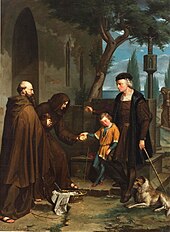
The name Christopher Columbus is the Anglicisation of the Latin Christophorus Columbus. His name in Italian is Cristoforo Colombo, and in Spanish, it is Cristóbal Colón. Columbus was born before 31 October 1451 in Genoa, part of modern Italy. His father was Domenico Colombo, a middle-class wool weaver who worked both in Genoa and Savona and who also owned a cheese stand at which young Christopher worked as a helper. Christopher's mother was Susanna Fontanarossa. Bartolomeo, Giovanni Pellegrino, and Giacomo were his brothers. Bartolomeo worked in a cartography workshop in Lisbon for at least part of his adulthood.
Columbus never wrote in his native language, which is presumed to have been a Genoese variety of Ligurian (his name would translate in 16th-century Genoese language as Christoffa Corombo pron. Template:IPA-lij). In one of his writings, Columbus claims to have gone to the sea at the age of 10. In 1470, the Columbus family moved to Savona, where Domenico took over a tavern. In the same year, Columbus was on a Genoese ship hired in the service of René I of Anjou to support his attempt to conquer the Kingdom of Naples. Some modern historians have argued that Columbus was not from Genoa, but instead, from Catalonia, Portugal, or Spain. These competing hypotheses have generally been discounted by mainstream scholars.
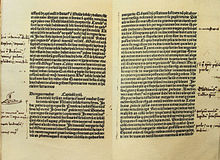
In 1473, Columbus began his apprenticeship as business agent for the important Centurione, Di Negro and Spinola families of Genoa. Later, he allegedly made a trip to Chios, a Genoese colony in the Aegean Sea. In May 1476, he took part in an armed convoy sent by Genoa to carry a valuable cargo to northern Europe. He docked in Bristol, England and Galway, Ireland. In 1477, he was possibly in Iceland. In 1479, Columbus reached his brother Bartolomeo in Lisbon, while continuing trading for the Centurione family. He married Filipa Moniz Perestrelo, daughter of the Porto Santo governor and Portuguese nobleman of Genoese origin Bartolomeu Perestrello. In 1479 or 1480, his son Diego Columbus was born. Between 1482 and 1485, Columbus traded along the coasts of West Africa, reaching the Portuguese trading post of Elmina at the Guinea coast. Some records report that Filipa died in 1485. It is also speculated that Columbus may have simply left his first wife. In either case, Columbus found a mistress in Spain in 1487, a 20-year-old orphan named Beatriz Enríquez de Arana.
Ambitious, Columbus eventually learned Latin, as well as Portuguese and Castilian, and read widely about astronomy, geography, and history, including the works of Ptolemy, Cardinal Pierre d'Ailly's Imago Mundi, the travels of Marco Polo and Sir John Mandeville, Pliny's Natural History, and Pope Pius II's Historia Rerum Ubique Gestarum. According to historian Edmund Morgan,
Columbus was not a scholarly man. Yet he studied these books, made hundreds of marginal notations in them and came out with ideas about the world that were characteristically simple and strong and sometimes wrong, the kind of ideas that the self-educated person gains from independent reading and clings to in defiance of what anyone else tries to tell him.
Throughout his life, Columbus also showed a keen interest in the Bible and in Biblical prophecies, and would often quote biblical texts in his letters and logs. For example, part of the argument that he submitted to the Spanish Catholic Monarchs when he sought their support for his proposed expedition to reach the Indies by sailing west was based on his reading of the Second Book of Esdras (see 2 Esdras 6:42, which Columbus took to mean that the Earth is made of six parts of land to one of water). Towards the end of his life, Columbus produced a Book of Prophecies, in which his career as an explorer is interpreted in the light of Christian eschatology and of apocalypticism.
Quest for Asia

Background
Under the Mongol Empire's hegemony over Asia (the so-called Pax Mongolica, or Mongol peace), Europeans had long enjoyed a safe land passage, the so-called "Silk Road", to China and India, which were sources of valuable goods such as silk, spices, and opiates. With the fall of Constantinople to the Ottoman Turks in 1453, the land route to Asia became much more difficult and dangerous. Portuguese navigators, under the leadership of King John II, sought to reach Asia by sailing around Africa. Major progress in this quest was achieved in 1488, when Bartolomeu Dias reached the Cape of Good Hope, in what is now South Africa. Meanwhile, in the 1480s, the Columbus brothers had developed a different plan to reach the Indies (then construed roughly as all of south and east Asia) by sailing west across the "Ocean Sea", i.e., the Atlantic.
Geographical considerations
Washington Irving's 1828 biography of Columbus popularized the idea that Columbus had difficulty obtaining support for his plan because many Catholic theologians insisted that the Earth was flat. In fact, most educated Westerners had understood that the Earth was spherical at least since the time of Aristotle, who lived in the 4th century BC and whose works were widely studied and revered in Medieval Europe. The sphericity of the Earth is also accounted for in the work of Ptolemy, on which ancient astronomy was largely based. Christian writers whose works clearly reflect the conviction that the Earth is spherical include Saint Bede the Venerable in his Reckoning of Time, written around AD 723. In Columbus's time, the techniques of celestial navigation, which use the position of the sun and the stars in the sky, together with the understanding that the Earth is a sphere, had long been in use by astronomers and were beginning to be implemented by mariners.
Where Columbus did differ from the view accepted by scholars in his day was in his estimate of the westward distance from Europe to Asia. Columbus's ideas in this regard were based on three factors: his low estimate of the size of the Earth, his high estimate of the size of the Eurasian landmass, and his belief that Japan and other inhabited islands lay far to the east of the coast of China. In all three of these issues Columbus was both wrong and at odds with the scholarly consensus of his day.
As far back as the 3rd century BC, Eratosthenes had correctly computed the circumference of the Earth by using simple geometry and studying the shadows cast by objects at two different locations: Alexandria and Syene (modern-day Aswan). Eratosthenes's results were confirmed by a comparison of stellar observations at Alexandria and Rhodes, carried out by Posidonius in the 1st century BC. These measurements were widely known among scholars, but confusion about the old-fashioned units of distance in which they were expressed had led, in Columbus's day, to some debate about the exact size of the Earth.

From d'Ailly's Imago Mundi Columbus learned of Alfraganus's estimate that a degree of latitude (or a degree of longitude along the Equator) spanned 56⅔ miles, but did not realize that this was expressed in the Arabic mile (about 1,830 m) rather than the shorter Roman mile with which he was familiar (1,480 m). He therefore estimated the circumference of the Earth to be about 30,200 km, whereas the correct value is 40,000 km (25,000 mi).
Furthermore, most scholars accepted Ptolemy's estimate that Eurasia spanned 180° longitude, rather than the actual 130° (to the Chinese mainland) or 150° (to Japan at the latitude of Spain). Columbus, for his part, believed the even higher estimate of Marinus of Tyre, which put the longitudinal span of the Eurasian landmass at 225°, leaving only 135° of water. He also believed that Japan (which he called "Cipangu", following Marco Polo) was much larger, further to the east from China ("Cathay"), and closer to the Equator than it is, and that there were inhabited islands even further to the east than Japan, including the mythical Antillia, which he thought might lie not much further to the west than the Azores. In this, he was influenced by the ideas of Florentine physician Paolo dal Pozzo Toscanelli, who corresponded with Columbus before his death in 1482 and who also defended the feasibility of a westward route to Asia.
Columbus therefore estimated the distance from the Canary Islands to Japan to be about 3,000 Italian miles (3,700 km, or 2,300 statute miles), while the correct figure is 19,600 km (12,200 mi), or about 12,000 km along a great circle. No ship in the 15th century could carry enough food and fresh water for such a long voyage, and the dangers involved in navigating through the uncharted ocean would have been formidable. Most European navigators reasonably concluded that a westward voyage from Europe to Asia was unfeasible. The Catholic Monarchs, however, having completed an expensive war in the Iberian Peninsula, were desperate for a competitive edge over other European countries in the quest for trade with the Indies. Columbus promised such an advantage.
Nautical considerations
Though Columbus was wrong about the number of degrees of longitude that separated Europe from the Far East and about the distance that each degree represented, he did possess valuable knowledge about the trade winds, which would prove to be the key to his successful navigation of the Atlantic Ocean. During his first voyage in 1492, the brisk trade winds from the east, commonly called "easterlies", propelled Columbus's fleet for five weeks, from the Canary Islands to The Bahamas. To return to Spain against this prevailing wind would have required several months of an arduous sailing technique, called beating, during which food and drinkable water would probably have been exhausted.
Instead, Columbus returned home by following the curving trade winds northeastward to the middle latitudes of the North Atlantic, where he was able to catch the "westerlies" that blow eastward to the coast of Western Europe. There, in turn, the winds curve southward towards the Iberian Peninsula.
It is unclear whether Columbus learned about the winds from his own sailing experience or if he had heard about them from others. The corresponding technique for efficient travel in the Atlantic appears to have been discovered first by the Portuguese, who referred to it as the Volta do mar ("turn of the sea"). Columbus's knowledge of the Atlantic wind patterns was, however, imperfect at the time of his first voyage. By sailing directly due west from the Canary Islands during hurricane season, skirting the so-called horse latitudes of the mid-Atlantic, Columbus risked either being becalmed or running into a tropical cyclone, both of which he luckily avoided.
Quest for support
In 1485, Columbus presented his plans to John II, King of Portugal. He proposed that the king equip three sturdy ships and grant Columbus one year's time to sail out into the Atlantic, search for a western route to the Orient, and return.

Columbus also requested he be made "Great Admiral of the Ocean", appointed governor of any and all lands he discovered, and given one-tenth of all revenue from those lands.
The king submitted Columbus's proposal to his experts, who rejected it. It was their considered opinion that Columbus's estimation of a travel distance of 2,400 miles (3,860 km) was, in fact, far too low.
In 1488, Columbus appealed to the court of Portugal once again, and once again, John II invited him to an audience. That meeting also proved unsuccessful, in part because not long afterwards Bartolomeu Dias returned to Portugal with news of his successful rounding of the southern tip of Africa (near the Cape of Good Hope). With an eastern sea route to Asia apparently at hand, King John was no longer interested in Columbus's far-fetched project.
Columbus traveled from Portugal to both Genoa and Venice, but he received encouragement from neither. Columbus had also dispatched his brother Bartholomew to the court of Henry VII of England, to inquire whether the English crown might sponsor his expedition, but also without success.
Columbus had sought an audience from the monarchs Ferdinand II of Aragon and Isabella I of Castile, who had united many kingdoms in the Iberian Peninsula by marrying, and were ruling together. On 1 May 1486, permission having been granted, Columbus presented his plans to Queen Isabella, who, in turn, referred it to a committee. After the passing of much time, the savants of Spain, like their counterparts in Portugal, replied that Columbus had grossly underestimated the distance to Asia. They pronounced the idea impractical and advised their Royal Highnesses to pass on the proposed venture.
However, to keep Columbus from taking his ideas elsewhere, and perhaps to keep their options open, the Catholic Monarchs gave him an annual allowance of 12,000 maravedis and, in 1489, furnished him with a letter ordering all cities and towns under their domain to provide him food and lodging at no cost.

U.S. stamps reflecting the most commonly held view as to what Columbus's first fleet might have looked like. The Santa Maria, the flagship of Columbus's fleet, was a carrack—a merchant ship of between 400 and 600 tons, 75 feet (23 m) long, with a beam of 25 feet (7.6 m), allowing it to carry more people and cargo. It had a deep draft of 6 feet (1.8 m). The vessel had three masts: a mainmast, a foremast, and a mizzenmast. Five sails altogether were attached to these masts. Each mast carried one large sail. The foresail and mainsail were square; the sail on the mizzen was a triangular sail known as a lateen mizzen. The ship had a smaller topsail on the mainmast above the mainsail and on the foremast above the foresail. In addition, the ship carried a small square sail, a spritsail, on the bowsprit.
Agreement with the Spanish crown
After continually lobbying at the Spanish court and two years of negotiations, he finally had success in 1492. Ferdinand and Isabella had just conquered Granada, the last Muslim stronghold on the Iberian Peninsula, and they received Columbus in Córdoba, in the Alcázar castle. Isabella turned Columbus down on the advice of her confessor, and he was leaving town by mule in despair, when Ferdinand intervened. Isabella then sent a royal guard to fetch him, and Ferdinand later claimed credit for being "the principal cause why those islands were discovered".
About half of the financing was to come from private Italian investors, whom Columbus had already lined up. Financially broke after the Granada campaign, the monarchs left it to the royal treasurer to shift funds among various royal accounts on behalf of the enterprise. Columbus was to be made "Admiral of the Seas" and would receive a portion of all profits. The terms were unusually generous, but as his son Diego later wrote, the monarchs did not really expect him to return.
In the "Capitulations of Santa Fe", King Ferdinand and Queen Isabella promised Columbus that if he succeeded he would be given the rank of Admiral of the Ocean Sea and appointed Viceroy and Governor of all the new lands he could claim for Spain. He had the right to nominate three persons, from whom the sovereigns would choose one, for any office in the new lands. He would be entitled to 10% of all the revenues from the new lands in perpetuity. Additionally, he would also have the option of buying one-eighth interest in any commercial venture with the new lands and receive one-eighth of the profits.
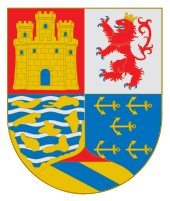
Columbus was later arrested in 1500 and dismissed from his posts. He and his sons, Diego and Fernando, then conduced a lengthy series of court cases against the Castilian crown, known as the pleitos colombinos, alleging that the Crown had illegally reneged on its contractual obligations to Columbus and his heirs. The Columbus family had some success in their first litigation, as a judgment of 1511 confirmed Diego's position as Viceroy, but reduced his powers. Diego resumed litigation in 1512, which lasted until 1536, and further disputes continued until 1790.
Voyages
Main article: Voyages of Christopher Columbus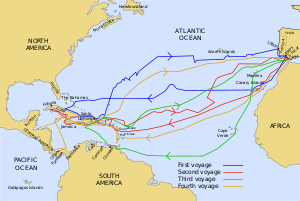
Between 1492 and 1503, Columbus completed four round-trip voyages between Spain and the Americas, all of them under the sponsorship of the Crown of Castile. These voyages marked the beginning of the European exploration and colonization of the American continents, and are thus of enormous significance in Western history. Columbus himself always insisted, in the face of mounting evidence to the contrary, that the lands that he visited during those voyages were part of the Asian continent, as previously described by Marco Polo and other European travelers. Columbus's refusal to accept that the lands he had visited and claimed for Spain were not part of Asia might explain, in part, why the American continent was named after the Florentine explorer Amerigo Vespucci and not after Columbus.
First voyage

On the evening of 3 August 1492, Columbus departed from Palos de la Frontera with three ships: a larger carrack, the Santa María ex-Gallega ("Galician"), and two smaller caravels, the Pinta ("Painted") and the Santa Clara, nicknamed the Niña (lit. "Girl") after her owner Juan Niño of Moguer. The monarchs forced the Palos inhabitants to contribute to the expedition. The Santa María was owned by Juan de la Cosa and captained by Columbus. The Pinta and the Niña were piloted by the Pinzón brothers (Martín Alonso and Vicente Yáñez).
Columbus first sailed to the Canary Islands, which belonged to the Castile, where he restocked the provisions and made repairs. After stopping over in Gran Canaria, he finally departed from San Sebastián de La Gomera on 6 September, for what turned out to be a five-week voyage across the ocean. A lookout on the Pinta, Rodrigo de Triana (also known as Juan Rodríguez Bermeo), spotted land about 2:00 on the morning of 12 October, and immediately alerted the rest of the crew with a shout. Thereupon, the captain of the Pinta, Martín Alonso Pinzón, verified the discovery and alerted Columbus by firing a lombard. Columbus later maintained that he himself had already seen a light on the land a few hours earlier, thereby claiming for himself the lifetime pension promised by Ferdinand and Isabella to the first person to sight land.
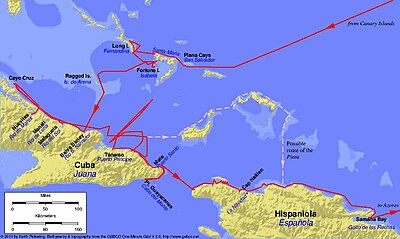
Columbus called the island (in what is now The Bahamas) San Salvador; the natives called it Guanahani. Exactly which island in the Bahamas this corresponds to is an unresolved topic; prime candidates are Samana Cay, Plana Cays, or San Salvador Island (so named in 1925 in the belief that it was Columbus's San Salvador). The indigenous people he encountered, the Lucayan, Taíno, or Arawak, were peaceful and friendly. From the 12 October 1492 entry in his journal, in which he wrote of them, "Many of the men I have seen have scars on their bodies, and when I made signs to them to find out how this happened, they indicated that people from other nearby islands come to San Salvador to capture them; they defend themselves the best they can. I believe that people from the mainland come here to take them as slaves. They ought to make good and skilled servants, for they repeat very quickly whatever we say to them. I think they can very easily be made Christians, for they seem to have no religion. If it pleases our Lord, I will take six of them to Your Highnesses when I depart, in order that they may learn our language." He remarked that their lack of modern weaponry and even metal-forged swords or pikes was a tactical vulnerability, writing, "I could conquer the whole of them with 50 men, and govern them as I pleased."
Columbus also explored the northeast coast of Cuba, where he landed on 28 October. On 22 November, Martín Alonso Pinzón took the Pinta on an unauthorized expedition in search of an island called "Babeque" or "Baneque", which the natives had told him was rich in gold. Columbus, for his part, continued to the northern coast of Hispaniola, where he landed on 5 December.
There, the Santa María ran aground on Christmas Day 1492 and had to be abandoned. Columbus was received by the native cacique Guacanagari, who gave him permission to leave some of his men behind. Columbus left 39 men, including Luis de Torres, the Converso interpreter, who spoke Hebrew and Arabic, and founded the settlement of La Navidad at the site of present-day Môle-Saint-Nicolas, Haiti. He kept sailing along the northern coast of Hispaniola with a single ship, until he encountered Pinzón and the Pinta on 6 January.
On 13 January 1493, Columbus made his last stop in the New World. He landed on the Samaná Peninsula, where he met the hostile Ciguayos who presented him with his only violent resistance during his first voyage to the Americas. Because of this and because of the Ciguayos' use of arrows, he called the inlet where he met them the Bay of Arrows (or Gulf of Arrows). Today, the place is called the Bay of Rincón, in Samaná, the Dominican Republic. Columbus kidnapped about 10 to 25 natives and took them back with him (only seven or eight of the native Indians arrived in Spain alive, but they made quite an impression on Seville).
Columbus headed for Spain, but another storm forced him into Lisbon. He anchored next to the King's harbor patrol ship on 4 March 1493 in Portugal. After spending more than one week in Portugal, he set sail for Spain. He crossed the bar of Saltes and entered the harbor of Palos on 15 March 1493. Word of his finding new lands rapidly spread throughout Europe.
Second voyage
Columbus left the port of Cadiz on 24 September 1493, with a fleet of 17 ships carrying 1,200 men and the supplies to establish permanent colonies in the New World. The colonists included priests, farmers, and soldiers. This reflected the new policy of creating not just "colonies of exploitation", but also "colonies of settlement" from which to launch missions dedicated to converting the natives to Christianity. Modern studies suggest that, as reported by the Washington Post, "crew members may have included free black Africans who arrived in the New World about a decade before the slave trade began."
As in the first voyage, the fleet stopped at the Canary Islands, from which it departed on 13 October, following a more southerly course than on the previous expedition. On 3 November, Columbus sighted a rugged island that he named Dominica (Latin for Sunday); later that day, he landed at Marie-Galante, which he named Santa María la Galante. After sailing past Les Saintes (Los Santos, "The Saints"), he arrived at the island of Guadeloupe, which he named Santa María de Guadalupe de Extremadura, after the image of the Virgin Mary venerated at the Spanish monastery of Villuercas, in Guadalupe, Cáceres, Spain. He explored that island from 4 to 10 November.
Michele da Cuneo, Columbus's childhood friend from Savona, sailed with Columbus during the second voyage and wrote: "In my opinion, since Genoa was Genoa, there was never born a man so well equipped and expert in the art of navigation as the said lord Admiral." Columbus named the small island of "Saona ... to honor Michele da Cuneo, his friend from Savona." The same childhood friend reported in a letter that Columbus had provided one of the captured indigenous women to him. He wrote, "While I was in the boat, I captured a very beautiful Carib woman, whom the said Lord Admiral gave to me. When I had taken her to my cabin she was naked - as was their custom. I was filled with a desire to take my pleasure with her and attempted to satisfy my desire. She was unwilling, and so treated me with her nails that I wished I had never begun. But - to cut a long story short - I then took a piece of rope and whipped her soundly, and she let forth such incredible screams that you would not have believed your ears. Eventually we came to such terms, I assure you, that you would have thought that she had been brought up in a school for whores." This letter has been interpreted by some as providing evidence that Columbus knowingly aided the rape of captured indigenous people.
Pedro de las Casas, father of the priest Bartolomé de las Casas, also accompanied Columbus on this voyage.
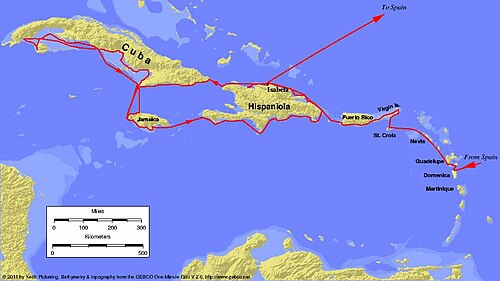
The exact course of Columbus's voyage through the Lesser Antilles is debated, but it seems likely that he turned north, sighting and naming several islands, including:
- Montserrat (for Santa María de Montserrate, after the Blessed Virgin of the Monastery of Montserrat, which is located on the Mountain of Montserrat, in Catalonia, Spain),
- Antigua (after a church in Seville, Spain, called Santa María la Antigua, meaning "Old St. Mary's"),
- Redonda (Santa María la Redonda, Spanish for "St. Mary the Round", owing to the island's shape),
- Nevis (derived from the Spanish Nuestra Señora de las Nieves, "Our Lady of the Snows", because Columbus thought the clouds over Nevis Peak made the island resemble a snow-capped mountain),
- Saint Kitts (for St. Christopher, patron of sailors and travelers),
- Sint Eustatius (for the early Roman martyr, St. Eustachius),
- Saba (after the Biblical Queen of Sheba),
- Saint Martin (San Martín), and
- Saint Croix (from the Spanish Santa Cruz, meaning "Holy Cross").
Columbus also sighted the chain of the Virgin Islands, which he named Islas de Santa Úrsula y las Once Mil Vírgenes, "Islands of Saint Ursula and the 11,000 Virgins" (shortened, both on maps of the time and in common parlance, to Islas Vírgenes). He also named the islands of Virgin Gorda ("Fat Virgin"), Tortola, and Peter Island (San Pedro).
He continued to the Greater Antilles, and landed in Puerto Rico, which he named San Juan Bautista in honor of Saint John the Baptist (a name that was later retained only for the capital city of San Juan). One of the first skirmishes between native Americans and Europeans since the time of the Vikings occurred when Columbus's men rescued two boys who had just been castrated by their captors.
On 22 November, Columbus returned to Hispaniola, where he intended to visit the fort of La Navidad, built during his first voyage and located on the northern coast of Haiti. Columbus found the fort in ruins, destroyed by the native Taino people. Among the ruins were the corpses of 11 of the 39 Spaniards who had stayed behind as the first colonists in the New World.
In retaliation for the attack on La Navidad, Columbus demanded that each Taino over 14 years of age deliver a hawk's bell full of gold powder every three months or, when this was lacking, twenty-five pounds of spun cotton. If this tribute was not delivered, the Taínos had their hands cut off and were left to bleed to death. Columbus then sailed more than 100 kilometers eastwards along the northern coast of Hispaniola, establishing a new settlement, which he called La Isabela, in the present-day Dominican Republic. However, La Isabela proved to be poorly located and the settlement was short-lived.
Columbus left Hispaniola on 24 April 1494, arriving at Cuba (which he named Juana) on 30 April. He explored the southern coast of Cuba, which he believed to be part of a peninsula attached to mainland Asia, as well as several nearby islands, including the Isle of Pines (which he named La Evangelista, "The Evangelist"). He reached Jamaica on 5 May. He retraced his route to Hispaniola, arriving on 20 August, before he finally returned to Spain.
Third voyage
On 30 May 1498, Columbus left with six ships from Sanlúcar, Spain, for his third trip to the New World. Three of the ships headed directly for Hispaniola with much-needed supplies, while Columbus took the other three in an exploration of what might lie to the south of the Caribbean islands he had already visited, including a hope-for passage to continental Asia.
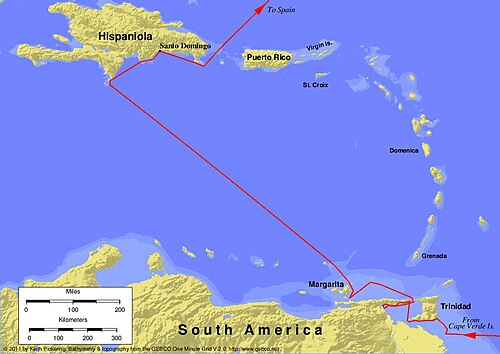
Columbus led his fleet to the Portuguese island of Porto Santo, his wife's native land. He then sailed to Madeira and spent some time there with the Portuguese captain João Gonçalves da Camara, before sailing to the Canary Islands and Cape Verde. As he crossed the Atlantic, Columbus discovered that the angle between North as indicated by a magnetic compass and North as measured by the position of the pole star changed with his position (a phenomenon now known as "compass variation"). He would later use his previous measurements of the compass variation to adjust his reckoning.
After being becalmed for several days in the doldrums of the mid-Atlantic, Columbus's fleet regained its wind and, dangerously low on water, turned north in the direction of Dominica, which Columbus had visited in his previous voyage. The ships landed on the southern coast of the island of Trinidad on 31 July. After resupplying with food and water, from 4 to 12 August Columbus explored the Gulf of Paria, which separates Trinidad from what is now Venezuela, near the delta of the Orinoco River. He then touched the mainland of South America at the Paria Peninsula.
Columbus correctly interpreted the enormous quantity of fresh water that the Orinoco delivered into the Atlantic Ocean as evidence that he had reached a continental landmass. As he sailed the Gulf of Paria, he observed the diurnal rotation of the pole star in the sky, which he erroneously interpreted as evidence that the Earth was not perfectly spherical, but rather bulged out like a pear around the new-found continent. He also speculated that the new continent might be the location of the biblical Garden of Eden. He then sailed to the islands of Chacachacare and Margarita. He sighted Tobago (which he named "Bella Forma") and Grenada (which he named "Concepción").
In poor health, Columbus returned to Hispaniola on 19 August, only to find that many of the Spanish settlers of the new colony were in rebellion against his rule, claiming that Columbus had misled them about the supposedly bountiful riches of the New World. A number of returning settlers and sailors lobbied against Columbus at the Spanish court, accusing him and his brothers of gross mismanagement. Columbus had some of his crew hanged for disobedience. He had an economic interest in the enslavement of the Hispaniola natives and for that reason was not eager to baptize them, which attracted criticism from some churchmen. An entry in his journal from September 1498 reads: "From here one might send, in the name of the Holy Trinity, as many slaves as could be sold..."
Columbus was eventually forced to make peace with the rebellious colonists on humiliating terms. In 1500, the Crown had him removed as governor, arrested, and transported in chains to Spain (see Governorship and arrest section below). He was eventually freed and allowed to return to the New World, but not as governor.
Fourth voyage
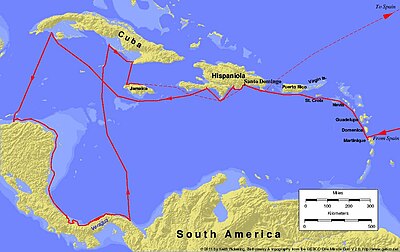
Before leaving for his fourth voyage, Columbus wrote a letter to the Governors of the Bank of St. George, Genoa, dated at Seville, 2 April 1502. He wrote "Although my body is here my heart is always near you."
Columbus made a fourth voyage nominally in search of the Strait of Malacca to the Indian Ocean. Accompanied by his brother Bartolomeo and his 13-year-old son Fernando, he left Cadiz on 11 May 1502, with his flagship Santa María and the vessels Gallega, Vizcaína, and Santiago de Palos. He sailed to Arzila on the Moroccan coast to rescue Portuguese soldiers whom he had heard were under siege by the Moors. On 15 June they landed at Carbet on the island of Martinique (Martinica). A hurricane was brewing, so he continued on, hoping to find shelter on Hispaniola. He arrived at Santo Domingo on 29 June but was denied port, and the new governor refused to listen to his storm prediction. Instead, while Columbus's ships sheltered at the mouth of the Rio Jaina, the first Spanish treasure fleet sailed into the hurricane. Columbus's ships survived with only minor damage, while 29 of the 30 ships in the governor's fleet were lost to the 1 July storm. In addition to the ships, 500 lives (including that of the governor, Francisco de Bobadilla) and an immense cargo of gold were surrendered to the sea.
After a brief stop at Jamaica, Columbus sailed to Central America, arriving at Guanaja (Isla de Pinos) in the Bay Islands off the coast of Honduras on 30 July. Here Bartolomeo found native merchants and a large canoe, which was described as "long as a galley" and was filled with cargo. On 14 August he landed on the continental mainland at Puerto Castilla, near Trujillo, Honduras. He spent two months exploring the coasts of Honduras, Nicaragua, and Costa Rica, before arriving in Almirante Bay in Panama on 16 October.
On 5 December 1502, Columbus and his crew found themselves in a storm unlike any they had ever experienced. In his journal Columbus writes,
For nine days I was as one lost, without hope of life. Eyes never beheld the sea so angry, so high, so covered with foam. The wind not only prevented our progress, but offered no opportunity to run behind any headland for shelter; hence we were forced to keep out in this bloody ocean, seething like a pot on a hot fire. Never did the sky look more terrible; for one whole day and night it blazed like a furnace, and the lightning broke with such violence that each time I wondered if it had carried off my spars and sails; the flashes came with such fury and frightfulness that we all thought that the ship would be blasted. All this time the water never ceased to fall from the sky; I do not say it rained, for it was like another deluge. The men were so worn out that they longed for death to end their dreadful suffering.

In Panama, Columbus learned from the natives of gold and a strait to another ocean. After much exploration, in January 1503 he established a garrison at the mouth of the Belén River. On 6 April one of the ships became stranded in the river. At the same time, the garrison was attacked and the other ships were damaged. Shipworms also damaged the ships in tropical waters. Columbus left for Hispaniola on 16 April heading north. On 10 May he sighted the Cayman Islands, naming them "Las Tortugas" after the numerous sea turtles there. His ships next sustained more damage in a storm off the coast of Cuba. Unable to travel farther, on 25 June 1503 they were beached in St. Ann's Bay, Jamaica.
For one year Columbus and his men remained stranded on Jamaica. A Spaniard, Diego Méndez, and some natives paddled a canoe to get help from Hispaniola. The governor, Nicolás de Ovando y Cáceres, detested Columbus and obstructed all efforts to rescue him and his men. In the meantime Columbus, in a desperate effort to induce the natives to continue provisioning him and his hungry men, successfully won their favor by predicting a lunar eclipse for 29 February 1504, using the Ephemeris of the German astronomer Regiomontanus. Help finally arrived, no thanks to the governor, on 29 June 1504, and Columbus and his men arrived in Sanlúcar, Spain, on 7 November.
Governorship and arrest
Under the terms of the Capitulations of Santa Fe, after his first voyage Columbus was appointed Viceroy and Governor of the Indies, which in practice entailed primarily the administration of the colonies in the island of Hispaniola, whose capital was established in Santo Domingo. By the end of his third voyage, Columbus was physically and mentally exhausted: his body was wracked by arthritis and his eyes by ophthalmia. In October 1499, he sent two ships to Spain, asking the Court of Spain to appoint a royal commissioner to help him govern. By then, accusations of tyranny and incompetence on the part of Columbus had also reached the Court.
The Court appointed Francisco de Bobadilla, a member of the Order of Calatrava, but not as the aide that Columbus had requested. Instead, Bobadilla was given complete control as governor from 1500 until his death in 1502. Arriving in Santo Domingo while Columbus was away, Bobadilla was immediately peppered with complaints about all three Columbus brothers: Christopher, Bartolomé, and Diego. Consuelo Varela, a Spanish historian, states: "Even those who loved him had to admit the atrocities that had taken place."
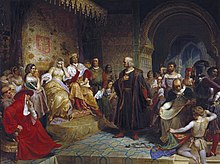
As a result of these testimonies and without being allowed a word in his own defense, Columbus, upon his return, had manacles placed on his arms and chains on his feet and was cast into prison to await return to Spain. He was 48 years old.
On 1 October 1500, Columbus and his two brothers, likewise in chains, were sent back to Spain. Once in Cadiz, a grieving Columbus wrote to a friend at court:
It is now seventeen years since I came to serve these princes with the Enterprise of the Indies. They made me pass eight of them in discussion, and at the end rejected it as a thing of jest. Nevertheless I persisted therein... Over there I have placed under their sovereignty more land than there is in Africa and Europe, and more than 1,700 islands... In seven years I, by the divine will, made that conquest. At a time when I was entitled to expect rewards and retirement, I was incontinently arrested and sent home loaded with chains... The accusation was brought out of malice on the basis of charges made by civilians who had revolted and wished to take possession on the land.... I beg your graces, with the zeal of faithful Christians in whom their Highnesses have confidence, to read all my papers, and to consider how I, who came from so far to serve these princes... now at the end of my days have been despoiled of my honor and my property without cause, wherein is neither justice nor mercy.
According to an uncatalogued document supposedly discovered very late in history purporting to be a record of Columbus's trial which contained the alleged testimony of 23 witnesses, Columbus regularly used barbaric acts of torture to govern Hispaniola.
Columbus and his brothers lingered in jail for six weeks before busy King Ferdinand ordered their release. Not long after, the king and queen summoned the Columbus brothers to the Alhambra palace in Granada. There the royal couple heard the brothers' pleas; restored their freedom and wealth; and, after much persuasion, agreed to fund Columbus's fourth voyage. But the door was firmly shut on Columbus's role as governor. Henceforth Nicolás de Ovando y Cáceres was to be the new governor of the West Indies.
Later life
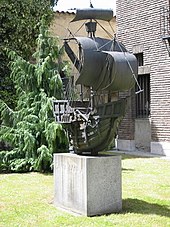

While Columbus had always given the conversion of non-believers as one reason for his explorations, he grew increasingly religious in his later years. Probably with the assistance of his son Diego and his friend the Carthusian monk Gaspar Gorricio, Columbus produced two books during his later years: a Book of Privileges (1502), detailing and documenting the rewards from the Spanish Crown to which he believed he and his heirs were entitled, and a Book of Prophecies (1505), in which passages from the Bible were used to place his achievements as an explorer in the context of Christian eschatology.
In his later years, Columbus demanded that the Spanish Crown give him 10% of all profits made in the new lands, as stipulated in the Capitulations of Santa Fe. Because he had been relieved of his duties as governor, the crown did not feel bound by that contract and his demands were rejected. After his death, his heirs sued the Crown for a part of the profits from trade with America, as well as other rewards. This led to a protracted series of legal disputes known as the pleitos colombinos ("Columbian lawsuits").
Death

On 20 May 1506, aged probably 54, Columbus died in Valladolid, Spain.

Columbus's remains were first interred at Valladolid, then at the monastery of La Cartuja in Seville (southern Spain) by the will of his son Diego, who had been governor of Hispaniola. In 1542 the remains were transferred to Colonial Santo Domingo, in the present-day Dominican Republic. In 1795, when France took over the entire island of Hispaniola, Columbus's remains were moved to Havana, Cuba. After Cuba became independent following the Spanish-American War in 1898, the remains were moved back to Spain, to the Cathedral of Seville, where they were placed on an elaborate catafalque.
However, a lead box bearing an inscription identifying "Don Christopher Columbus" and containing bone fragments and a bullet was discovered at Santo Domingo in 1877.
To lay to rest claims that the wrong relics had been moved to Havana and that Columbus's remains had been left buried in the cathedral at Santo Domingo, DNA samples of the corpse resting in Seville were taken in June 2003 (History Today August 2003) as well as other DNA samples from the remains of his brother Diego and younger son Fernando Colón. Initial observations suggested that the bones did not appear to belong to somebody with the physique or age at death associated with Columbus. DNA extraction proved difficult; only short fragments of mitochondrial DNA could be isolated. The mtDNA fragments matched corresponding DNA from Columbus's brother, giving support that both individuals had shared the same mother. Such evidence, together with anthropologic and historic analyses led the researchers to conclude that the remains found in Seville belonged to Christopher Columbus. The authorities in Santo Domingo have never allowed the remains there to be exhumed, so it is unknown if any of those remains could be from Columbus's body as well. The location of the Dominican remains is in "The Columbus Lighthouse" (Faro a Colón), in Santo Domingo.
Historians have traditionally argued that Columbus remained convinced to the very end that his journeys had been along the east coast of Asia, but writer Kirkpatrick Sale argues that a document in the Book of Privileges indicates Columbus knew he found a new continent. Furthermore, his journals from the third voyage call the "land of Paria" a "hitherto unknown" continent. On the other hand, his other writings continued to claim that he had reached Asia, such as a 1502 letter to Pope Alexander VI where he asserted that Cuba was the east coast of Asia. He also rationalized that the new continent of South America was the "Earthly Paradise" that was located "at the end of the Orient". Thus, it remains unclear what his true beliefs were.
Commemoration

The World Columbian Exposition in Chicago, 1893, commemorated the 400th anniversary of the landing of Christopher Columbus in the Americas. Over 27 million people attended the exposition during its six-month duration.
The U.S. Postal Service participated in the celebration issuing the first US commemorative postage stamps, a series of 16 postage issues called the Columbian Issue depicting Columbus, Queen Isabella and others in the various stages of his several voyages. The issues range in value from the 1-cent to the 5-dollar denominations. Under Benjamin Harrison and his Postmaster General John Wanamaker the Columbian commemorative stamps were made available and were first issued at the World Columbian Exposition in Chicago, Illinois, in 1893. Wanamaker originally introduced the idea of issuing the nation's first commemorative stamp to Harrison, the Congress and the U.S. Post Office. To demonstrate his confidence in the new Columbian commemorative issues Wanamaker purchased $10,000 worth of stamps with his own money. The Columbian Exposition lasted several months and, and over $40 million dollars in commemorative postage stamp had been sold. The 400th anniversary Columbian issues were very popular in the United States; more than a billion of the two-cent editions were printed.
In 1982, a second Columbian issue was released that was identical to the first to commemorate the 500th anniversary. These issues were made from the original dies of which the first engraved issues of 1893 were produced. In 1992 along with the United States, Spain also issued an almost identical series of Columbian issues, (using 'Spain' instead of 'United States of America') celebrating the 500th anniversary of the voyages.
Legacy

Although among non-Native Americans Christopher Columbus is traditionally considered the discoverer of America, Columbus was preceded by the various cultures and civilizations of the indigenous peoples of the Americas, as well as the Western world's Vikings at L'Anse aux Meadows. He is regarded more accurately as the person who brought the Americas to the forefront of Western attention. "Columbus's claim to fame isn't that he got there first," explains historian Martin Dugard, "it's that he stayed." The popular idea that he was the first person to envision a rounded earth is false. The rounded shape of the earth had already been known since antiquity.

Amerigo Vespucci's travel journals, published 1502-4, convinced Martin Waldseemüller that the discovered place was not India, as Columbus believed, but a new continent, and in 1507, a year after Columbus's death, Waldseemüller published a world map calling the new continent America from Vespucci's Latinized name "Americus". According to Paul Lunde, "The preoccupation of European courts with the rise of the Ottoman Turks in the East partly explains their relative lack of interest in Columbus's discoveries in the West."

Historically, the British had downplayed Columbus and emphasized the role of the Venetian John Cabot as a pioneer explorer, but for the emerging United States, Cabot made for a poor national hero. Veneration of Columbus in America dates back to colonial times. The name Columbia for "America" first appeared in a 1738 weekly publication of the debates of the British Parliament. The use of Columbus as a founding figure of New World nations and the use of the word "Columbia", or simply the name "Columbus", spread rapidly after the American Revolution. Columbus's name was given to the federal capital of the United States (District of Columbia), the capital cities of two U.S. states (Ohio and South Carolina), and the Columbia River. Outside the United States the name was used in 1819 for the Gran Colombia, a precursor of the modern Republic of Colombia. Numerous cities, towns, counties, streets, and plazas (called Plaza Colón or Plaza de Colón throughout Latin America and Spain) have been named after him. A candidate for sainthood in the Catholic Church in 1866, celebration of Columbus's legacy perhaps reached a zenith in 1892 with the 400th anniversary of his first arrival in the Americas. Monuments to Columbus like the Columbian Exposition in Chicago and Columbus Circle in New York City were erected throughout the United States and Latin America extolling him.
In 1909, descendants of Columbus undertook to dismantle the Columbus family chapel in Spain and move it to Boalsburg near State College, Pennsylvania, where it may now be visited by the public. At the museum associated with the chapel, there are a number of Columbus relics worthy of note, including the armchair that the "Admiral of the Ocean Sea" used at his chart table.
More recent views of Columbus, particularly those of Native Americans, have tended to be much more critical. This is because the native Taino of Hispaniola, where Columbus began a rudimentary tribute system for gold and cotton, disappeared so rapidly after contact with the Spanish, because of overwork and especially, after 1519, when the first pandemic struck Hispaniola, because of European diseases. Some estimates indicate case fatality rates of 80–90% in Native American populations during smallpox epidemics. The native Taino people of the island were systematically enslaved via the encomienda system, which resembled a feudal system in Medieval Europe. The pre-Columbian population is estimated to have been perhaps 250,000–300,000. According to the historian Gonzalo Fernandez de Oviedo y Valdes by 1548, 56 years after Columbus landed, fewer than five hundred Taino were left on the island. In another hundred years, perhaps only a handful remained. However, some analyses of the question of Columbus's legacy for Native Americans do not clearly distinguish between the actions of Columbus himself, who died well before the first pandemic to hit Hispaniola or the height of the encomienda system, and those of later European governors and colonists on Hispaniola.
There is evidence that the first voyage also brought syphilis back from the New World. Many of the crew members who served on this voyage later joined the army of King Charles VIII in his invasion of Italy in 1495 resulting in the spreading of the disease across Europe and as many as 5 million deaths.
The anniversary of Columbus's 1492 landing in the Americas is usually observed as Columbus Day on 12 October in Spain and throughout the Americas, except Canada. In the United States it is observed annually on the second Monday in October.
The term "pre-Columbian" is usually used to refer to the peoples and cultures of the Americas before the arrival of Columbus and his European successors.
Physical appearance
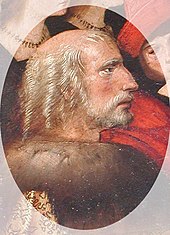
Although an abundance of artwork involving Christopher Columbus exists, no authentic contemporary portrait has been found. James W. Loewen, author of Lies My Teacher Told Me, said that the various posthumous portraits have no historical value.
Sometime between 1505 and 1536, Alejo Fernández painted an altarpiece, The Virgin of the Navigators, that includes a depiction of Columbus. The painting was commissioned for a chapel in Seville's Casa de Contratación (House of Trade) and remains there to this day, as the earliest known painting about the discovery of the Americas.
At the 1893 World's Columbian Exposition, 71 alleged portraits of Columbus were displayed; most did not match contemporary descriptions. These writings describe him as having reddish or blond hair, which turned to white early in his life, light colored eyes, as well as being a lighter-skinned person with too much sun exposure turning his face red. Accounts consistently describe Columbus as a large and physically strong man of some six feet or more in height, easily taller than the average European of his day.
The most iconic image of Columbus is a portrait by Sebastiano del Piombo, which has been reproduced in many textbooks. It agrees with descriptions of Columbus in that it shows a large man with auburn hair, but the painting dates from 1519 and cannot, therefore, have been painted from life. Furthermore, the inscription identifying the subject as Columbus was probably added later, and the face shown differs from other images, including that of the "Virgin of the Navigators."
Popular culture

Columbus, an important historical figure, has been depicted in fiction, cinema and television, and in other media and entertainment, such as stage plays, music, cartoons and games.
- In games
- Christopher Columbus appears as a Great Explorer in the 2008 strategy video game, Civilization Revolution.
- In literature
- In 1889, American author Mark Twain based the time traveler's trick in A Connecticut Yankee in King Arthur's Court on Columbus's successful prediction of a lunar eclipse during his fourth voyage to the New World.
- In 1941 the British author Rafael Sabatini published a novel Columbus, based on a screenplay he had written for a planned film. The story provided the inspiration for the 1949 film about Columbus.
- In 1958, the Italian playwright Dario Fo wrote a satirical play about Columbus titled Isabella, tre caravelle e un cacciaballe (Isabella, three tall ships and a con man). In 1997 Fo was awarded the Nobel Prize in Literature. The play was translated into English in 1988 by Ed Emery and is downloadable on the internet.
- In 1991, author Salman Rushdie published a fictional representation of Columbus in The New Yorker, "Christopher Columbus and Queen Isabella of Spain Consummate Their Relationship, Santa Fe, January, 1492".
- In Pastwatch: The Redemption of Christopher Columbus (1996) science fiction novelist Orson Scott Card focuses on Columbus's life and activities, but the novel's action also deals with a group of scientists from the future who travel back to the 15th century with the goal of changing the pattern of European contact with the Americas.
- British author Stephen Baxter includes Columbus's quest for royal sponsorship as a crucial historical event in his 2007 science fiction novel Navigator (ISBN 978-0-441-01559-7), the third entry in the author's Time's Tapestry Series.
- American novelist Steve Berry's 2012 book The Columbus Affair revolves around the premise that Columbus's voyages held a secret purpose, with clues to an ancient Jewish treasure.
- In music
- Christopher Columbus is regularly referred to by singers and musical groups in the Rastafari movement as an example of a European oppressor. The detractors include Burning Spear (Christopher Columbus), Culture (Capture Rasta), and Peter Tosh (You Can't Blame The Youth, Here Comes The Judge).
- On Screen
- Christopher Columbus is a 1949 film starring Fredric March as Columbus.
- The 1985 TV mini-series, Christopher Columbus, features Gabriel Byrne as Columbus.
- Columbus was portrayed by Gérard Depardieu in the 1992 film by Ridley Scott, 1492: Conquest of Paradise. Scott presented Columbus as a forward-thinking idealist, as opposed to the view that he was ruthless and responsible for the misfortune of Native Americans.
- Carry On Columbus is a 1992 comedy.

Columbus by Mary Lawrence - Christopher Columbus: The Discovery, is a 1992 biographical film by Alexander Salkind.
- The 42nd episode of The Sopranos, entitled "Christopher" (2002), addresses the controversies surrounding Columbus's legacy from the perspectives of numerous identity group members.
- In sculpture
- Isabella and Columbus by Larkin Mead, 1874, California State Capitol, Sacramento, California
- Christopher Columbus, by Moses Jacob Ezekiel, Arrigo Park, Chicago. Illinois, 1891
- Drake Fountain, also known as the Columbus Monument by Richard Henry Park, Chicago, Illinois, 1892
- Christopher Columbus by Ferdinand von Miller the Younger, St. Louis, Missouri, 1884, This work is different from most in that it shows a bearded Columbus. It is believed to be the first bronze statue of Columbus in the United States.
- Colossal Columbus statue by Mary Lawrence, 1893, at the World's Columbian Exposition, Chicago, Illinois,
- Columbus by Paul Wayland Bartlett ca. 1895 Library of Congress, Washington D.C.
- Christopher Columbus Memorial by Pietro Piai 1904, Pueblo, Colorado. "Colorado was the first state to make Columbus Day a legal holiday in 1905 and this is reportedly the first monument to Columbus erected in the United States."
- Christopher Columbus, by Augusto Rivalta, Detroit, Michigan, 1910,
- Columbus Fountain, by Lorado Taft, 1912, Washington D.C.
- Christopher Columbus, by Virgil Rainer, Chicago, Illinois, 1924
- Christopher Columbus by Charles Brioschi, assisted by Leo Lentelli, St. Paul, Minnesota, 1931
- Christopher Columbus by Charles Brioschi, Grant Park (Chicago), 1933
- Christopher Columbus, by Frank Vittor, Pittsburg, Pennsylvania, 1958
- Christopher Columbus Monument by David W. Oswald, Columbus, Wisconsin, 1988
- In space
- Asteroid 327 Columbia is named in his honour.
References
Footnotes
- Portraits of Christopher Columbus – COLUMBUS MONUMENTS PAGES. Vanderkrogt.
- ^ Christopher Columbus Encyclopædia Britannica. 2010. Encyclopædia Britannica Online. 8 June 2010. Cite error: The named reference "EB-online" was defined multiple times with different content (see the help page).
- Scholastic Teacher – Christopher Columbus (1451–1506) Teaching Resources, Children's Book Recommendations, and Student Activities. Milton Meltzer. Author, Columbus and the World Around Him.
- World Book – Columbus, Christopher "Columbus, Christopher". World Book Store has the encyclopedia, dictionary, atlas, homework help, study aids, and curriculum guides. 2010
- Questia – COLUMBUS, CHRISTOPHER "Columbus, Christopher". Questia – The Online Library of Books and Journals. 2010
Memorials Of Columbus: Or, A Collection Of Authentic Documents Of That Celebrated Navigator (page 9) Country of origin: USA. Pages: 428. Publisher: BiblioBazaar. Publication Date: 2010-01-01.
Native American History for Dummies (page 127) Authors: Dorothy Lippert, Stephen J. Spignesi and Phil Konstantin. Paperback: 364 pages. Publisher: For Dummies. Publication Date: 2007-10-29.
The peoples of the Caribbean: an encyclopedia of archeology and traditional culture (p. 67) Author: Nicholas J. Saunders. Hardcover: 399 pages. Publisher: ABC-CLIO. Publication Date: 15 July 2006. - "Parks Canada – L'Anse aux Meadows National Historic Site of Canada". Pc.gc.ca. 24 April 2009. Retrieved 29 July 2009.
- Hoxie, Frederic E. ed. Encyclopedia of North American Indians Houghton Mifflin (March 1997) ISBN 978-0-395-66921-1 p.568
- Herbst, Philip The Color of Words: An Encyclopaedic Dictionary of Ethnic Bias in the United States Intercultural Press Inc (31 December 1997) ISBN 978-1-877864-97-1 p.116
- Wilton, David; Brunetti, Ivan Word myths: debunking linguistic urban legends Oxford University Press USA (13 January 2005) ISBN 978-0-19-517284-3 pp. 164–165
- Phillips, William D., and Carla Rahn Phillips. The Worlds of Christopher Columbus. Cambridge: Cambridge University Press, 1992. Page 9.
"Even with less than a complete record, however, scholars can state with assurance that Columbus was born in the republic of Genoa in northern Italy, although perhaps not in the city itself, and that his family made a living in the wool business as weavers and merchants...The two main early biographies of Columbus have been taken as literal truth by hundreds of writers, in large part because they were written by individual closely connected to Columbus or his writings. ...Both biographies have serious shortcomings as evidence." - ^ Encyclopædia Britannica, 1993 ed., Vol. 16, pp. 605ff / Morison, Christopher Columbus, 1955 ed., pp. 14ff
- Rime diverse, Pavia, 1595, p.117
- Tasso, Torquato (1755). Ra Gerusalemme deliverâ. Genoa: Ra Stamparia de Tarigo. p. XV-32. Retrieved 2 February 2012.
- Çittara zeneize – Regole d'Ortografia, Genoa, 1745
- Consulta ligure, Vocabolario delle parlate liguri, SAGEP, 1982, ISBN 88-7058-044-X
- Telegraph, 14 October 2009, Georgetown University team led by Professor Estelle Irizarry claims that Christopher Columbus was Catalan
- da Silva, Manuel Luciano and Silvia Jorge da Silva, 2008. Christopher Columbus was Portuguese. Express Printers, Fall River. ISBN 978-1-60702-824-6.
- "Georgetown University". Explore.georgetown.edu. Retrieved 23 February 2010.
- Davidson (1997, pp.3ff), Phillips & Phillips (1992, pp.85ff)
- "Christopher Columbus". Thomas C. Tirado, PhD Professor History. Millersville University.
- "It is most probable that Columbus visited Bristol, where he was introduced to English commerce with Iceland." Bedini, Silvio A. and David Buisseret (1992). The Christopher Columbus encyclopedia, Volume 1, University of Michigan Press, republished by Simon & Schuster, ISBN 0-13-142670-2, p. 175
- "Christopher Columbus Biography Page 2". Columbus-day.123holiday.net. Retrieved 29 July 2009.
- Morgan, Edmund S. (2009). "Columbus' Confusion About the New World". Smithsonian Magazine.
- "Marco Polo et le Livre des Merveilles", p. 37. ISBN 978-2-35404-007-9
- Boller, Paul F (1995). Not So!:Popular Myths about America from Columbus to Clinton. New York: Oxford University Press. ISBN 978-0-19-509186-1.
- Russell, Jeffrey Burton 1991. Inventing the Flat Earth. Columbus and modern historians, Praeger, New York, Westport, London 1991;
Zinn, Howard 1980. A People's History of the United States, HarperCollins 2001. p.2 - See, e.g. "Mariner's Astrolabe", Navigation Museum, Institute of Navigation
- Sagan, Carl. Cosmos; the mean circumference of the Earth is 40,041.47 km (24,881 mi).
- Morison (1942, pp. 65,93).
- ^ Samuel Eliot Morison, Admiral of the Ocean Sea: The Life of Christopher Columbus, (Boston: Atlantic-Little, Brown, 1942). Reissued by the Morison Press, 2007. ISBN 1-4067-5027-1 Cite error: The named reference "Morison-Admiral" was defined multiple times with different content (see the help page).
- "The First Voyage Log". Retrieved 18 April 2008.
- "Christopher Columbus and the Spanish Empire". Retrieved 18 April 2008.
- "Trade Winds and the Hadley Cell". Retrieved 18 April 2008.
- "Columbus Monuments Pages: Madrid". Retrieved 3 January 2010.
- Durant, Will The Story of Civilization vol. vi, "The Reformation". Chapter XIII, page 260.
- "Christopher Columbus Ships". Elizabethan-era.org.uk. Retrieved 29 July 2010.
- "Columbus's Sailing Ships". Evgschool.org. Retrieved 29 July 2010.
- Phillips, William D.; Phillips, Carla Rahn (1993). The Worlds of Christopher Columbus. Cambridge University Press. p. 132. ISBN 978-0-521-44652-5.
- Mark McDonald, "Ferdinand Columbus, Renaissance Collector (1488–1539)", 2005, British Museum Press, ISBN 978-0-7141-2644-9
- "The Naming of America". Umc.sunysb.edu. Retrieved 10 April 2011.
- The Columbus Foundation. "The Original Nina".
- Morison (1942, p.226); Lopez, (1990, p. 14); Columbus & Toscanelli (2010, p. 35)
- Lopez, (1990, p. 15)
- Robert H. Fuson, ed., The Log of Christopher Columbus, Tab Books, 1992, International Marine Publishing, ISBN 0-87742-316-4.
- Columbus (1991, p.87). Or "for with fifty men they can all be subjugated and made to do what is required of them." (Columbus & Toscanelli, 2010, p.41)
- Keith A. Pickering, The First Voyage of Columbus
- Maclean, Frances (2008). "The Lost Fort of Columbus". Smithsonian Magazine. Retrieved 24 January 2008.
{{cite web}}: Unknown parameter|month=ignored (help) - Oliver Dunn and James Kelly, The Diario of Christopher Columbus's First Voyage to America (London: University of Oklahoma Press), 333–343.
- Robert Fuson, The Log of Christopher Columbus (Camden, International Marine, 1987) 173.
- James W. Loewen (1995). Lies My Teacher Told Me: Everything Your American History Textbook Got Wrong. ASIN 1402579373.
{{cite book}}: Check|asin=value (help); Unknown parameter|unused_data=ignored (help) - Baccus, M. Kazim Utilization, Misuse, and Development of Human Resources in the Early West Indian Colonies, Wilfrid Laurier University Press (2 January 2000) ISBN 978-0-88920-982-4 pp.6–7
- "Who Went With Columbus? Dental Studies Give Clues.". The Washington Post. 18 May 2009.
- Felipe Fernández-Armesto, Columbus, Oxford Univ. Press, (1991) pp. 103–104
- Paolo Emilio Taviani, Columbus the Great Adventure, Orion Books, New York (1991) p. 185
- Cohen, J.M. (1969). The Four Voyages of Christopher Columbus. NY: Penguin. p. 139. ISBN 978-0140442175.
- Traboulay, David M. (1994). Columbus and Las Casas. University Press of America. p. 48. ISBN 0-8191-9642-8.
- Phillips, Jr., William D. & Carla Rahn Phillips (1992). The Worlds of Christopher Columbus. Cambridge: Cambridge University Press. ISBN 978-0-521-35097-6.
{{cite book}}: CS1 maint: multiple names: authors list (link) - "The Spanish Conquest of the Tainos" – Latin American Studies – Retrieved 10 July 2011.
- "Teeth Of Columbus' Crew Flesh Out Tale Of New World Discovery". ScienceDaily. 20 March 2009.
- Christopher Minster, "The Third Voyage of Christopher Columbus"
- Varela (2006, p.111)
- Keith A. Pickering, "The Third Voyage of Columbus, 1498–1500"
- 'Letter from Christopher Columbus to the Governors of the Bank of St. George, Genoa. Dated at Seville, April 2nd, 1502'. Google Books. 1894. Retrieved 10 April 2011.
- The authentic letters of Columbus – Google Books. Google Books. 1894. Retrieved 29 July 2010.
- Morison, Samuel Eliot, Admiral of the Ocean Sea: A Life of Christopher Columbus, Boston, 1942, p. 617.
- The History Channel. Columbus: The Lost Voyage.
- Samuel Eliot Morison, Admiral of the Ocean Sea: A Life of Christopher Columbus, 1942, pp. 653–54. Samuel Eliot Morison, Christopher Columbus, Mariner, 1955, pp. 184–92.
- Giles Tremlett (7 August 2006). "Lost document reveals Columbus as tyrant of the Caribbean". The Guardian. UK. Retrieved 10 October 2006.
- Bobadilla's 48-page report—derived from the testimonies of 23 people who had seen or heard about the treatment meted out by Columbus and his brothers—had originally been lost for centuries, but was rediscovered in 2005 in the Spanish archives in Valladolid. It contained an account of Columbus's seven-year reign as the first Governor of the Indies.
- The Brooklyn Museum catalogue notes that the most likely source for Leutze's trio of Columbus paintings is Washington Irving's best-selling Life and Voyages of Columbus (1828).
- Samuel Eliot Morison, Admiral of the Ocean Sea: A Life of Christopher Columbus, p. 576.
- Varela (2006).
- "Columbus Monuments Pages: Valladolid". Retrieved 3 January 2010.
- "Columbus Monuments Pages: Sevilla". Retrieved 3 January 2010.
- John Boyd Thacher (1904). Christopher Columbus: his life, his works, his remains: as revealed by original printed and manuscript records, together with an essay on Peter Martyr of Anghera and Bartolomé de las Casas, the first historians of America. G. P. Putnam & Sons. Retrieved 27 December 2011.
- "''Cristóbal Colón: traslación de sus restos mortales a la ciudad de Sevilla'' at Fundación Biblioteca Virtual Miguel de Cervantes". Cervantesvirtual.com. Retrieved 29 July 2009.
- Giles Tremlett, Young bones lay Columbus myth to rest, The Guardian, 11 August 2004
- Lorenzi, Rossella (6 October 2004). "DNA Suggests Columbus Remains in Spain". Discovery News. Retrieved 11 October 2006.
- ^ DNA verifies Columbus's remains in Spain, Associated Press, 19 May 2006
- ^ Álvarez-Cubero, MJ (8 March 2010). "New applications in genetic identification". Cuadernos de Medicina Forense. 16 (1–2): 5–18. ISSN 1135-7606.
{{cite journal}}: Unknown parameter|coauthors=ignored (|author=suggested) (help) - Thomas F. McIlwraith; Edward K. Muller (2001). North America: the historical geography of a changing continent. Rowman & Littlefield. p. 35. ISBN 978-0-7425-0019-8.
- Sale, Kirkpatrick (1991). The Conquest of Paradise: Christopher Columbus and the Columbian Legacy, pp. 204–209
- ^ Eviatar Zerubavel (2003). Terra cognita: the mental discovery of America. Transaction Publishers. pp. 90–91. ISBN 978-0-7658-0987-2.
- Phillips, William D., and Carla Rahn Phillips. The Worlds of Christopher Columbus. Cambridge: Cambridge University Press, 1992, p. 227.
- "JOHN WANAMAKER, Postmaster General". United States Postal Service. Retrieved 19 January 2011.
- "Columbus Monuments Pages: Santo Domingo". Retrieved 3 January 2010.
- Dugard, Martin. The Last Voyage of Columbus. Little, Brown and Company: New York, 2005.
- "Piri Reis and the Columbus Map". Paul Lunde. Saudi Aramco World. May/June 1992.
- "Columbus Monuments Pages: Denver". Retrieved 3 January 2010.
- The Gentleman's Magazine, Vol. 8, June 1738, p. 285.
- "Columbus Monuments Pages: Boalsburg". Retrieved 3 January 2010.
- Howard Zinn. "Christopher Columbus and the Indians". Newhumanist.com. Archived from the original on 29 July 2008. Retrieved 5 September 2008.
- "Jack Weatherford, Examining the reputation of Christopher Columbus". Hartford-hwp.com. 20 April 2001. Retrieved 29 July 2009.
- "Pre-Columbian Hispaniola – Arawak/Taino Indians". Hartford-hwp.com. 15 September 2001. Retrieved 29 July 2009.
- Alfred W. Crosby, The Columbian Exchange, Westport, 1972, pp. 39, 47.
- Austin Alchon, Suzanne (2003). A pest in the land: new world epidemics in a global perspective. University of New Mexico Press. p. 62. ISBN 0-8263-2871-7.
- "The Cambridge encyclopedia of human paleopathology". Arthur C. Aufderheide, Conrado Rodríguez-Martín, Odin Langsjoen (1998). Cambridge University Press. p. 205. ISBN 0-521-55203-6.
- "Encomienda or Slavery? The Spanish Crown's Choice of Labor Organization in Sixteenth-Century Spanish America." (PDF). Latin American Studies.
- Lyle N. McAlister (1984). "Spain and Portugal in the New World, 1492-1700". University of Minnesota Press. p.164. ISBN 0816612188.
- Alfred Crosby, The Columbian Exchange (Westport, 1972) p. 45.
- Harper, Kristin; et al. (2008). "On the Origin of the Treponematoses: A Phylogenetic Approach". Retrieved 21 January 2008.
{{cite web}}: Explicit use of et al. in:|last=(help); Unknown parameter|month=ignored (help) - CBC News Staff (2008). "Study traces origins of syphilis in Europe to New World". Retrieved 15 January 2008.
{{cite news}}: Unknown parameter|month=ignored (help) - Alden, Henry Mills. Harper's New Monthly Magazine. Volume 84, Issues 499–504. Published by Harper & Brothers, 1892. Originally from Harvard University. Digitized on 16 December 2008. 732. Retrieved on 8 September 2009. 'Major, Int. Letters of Columbus, ixxxviii., says "Not one of the so-called portraits of Columbus is unquestionably authentic." They differ from each other, and cannot represent the same person.'
- Loewen, James W. Lies My Teacher Told Me. 1st Touchstone ed, Simon & Schuster, 1996. ISBN 0-684-81886-8. 55.
- John Noble, Susan Forsyth, Vesna Maric, Paula Hardy. Andalucía. Lonely Planet, 2007, p. 100
- Linda Biesele Hall, Teresa Eckmann. Mary, mother and warrior, University of Texas Press, 2004, p. 46
- Morison, Samuel Eliot Admiral of the Ocean Sea: A Life of Christopher Columbus, pg. 47–48, Boston 1942.
- Bartolomé de Las Casas, Historia de las Indias, ed. Agustín Millares Carlo, 3 vols. (Mexico City, 1951), book 1, chapter 2, 1:29. The Spanish word garzos is now usually translated as "light blue," but it seems to have connoted light grey-green or hazel eyes to Columbus's contemporaries. The word rubio can mean "blonde," "fair," or "ruddy." The Worlds of Christopher Columbus by William D. and Carla Rahn Phillips, p. 282.
- "DNA Tests on the bones of Christopher Columbus's bones, on his relatives and on Genoese and Catalin claimaints". Retrieved 9 February 2009.
- "Portrait of a Man, Said to be Christopher Columbus", Metropolitan Museum of Art
- "Columbus Monuments Pages: Sacramento". Retrieved 3 January 2010.
- Civilization Revolution: Great People "CivFanatics" Retrieved on 4 September 2009
- "Dario Fo Archives online". Archived from the original on 21 October 2009. Retrieved 12 October 2009.
- The New Yorker, 17 June 1991, p. 32.
- Bach, Ira and Mary Lackritz Gray, A Guide to Chicago's Public Sculpture, The University of Chicago Press, Chicago, 1983 p. 226
- Riedy, James L., Chicago Sculpture, University of Illinois Press, Urbana, Illinois, 1981 pp. 203–204
- McCue, George, Photographs by David Finn and Amy Binder, Sculpture City: St. Louis, Sculpture in the "Gateway to the West" Hudson Hills Press NY and Laumeier Sculpture Park, St. Louis, 1988, pp. 43–45
- Photographs if the World's Fair: An elaborate Collection of Photographs of the Buildings, Grounds and the Exhibits of the World's Columbian Exposition with a special description of The Famaous Midway Exposition, The Werner Company, Chicago, 1894, p. 191
- Small, Herbert, The Library of Congress: The Architecture and Decoration, Classical America, WW Norton & Company, New York, 1982, p. 93
- "Christopher Columbus Memorial, (sculpture)". Siris-artinventories.si.edu. Retrieved 15 August 2011.
- Nawrocki, Dennis Alan, Art in Detroit Public Places, Wayne State University Press, Detroit, Michigan, 1980, p. 26
- Riedy, James L., Chicago Sculpture, University of Illinois Press, Urbana, Illinois, 1981, pp. 204–205
- "Chicago – Christopher Columbus". Vanderkrogt.net. 21 November 2010. Retrieved 2 February 2012.
- Harris, Moira A., Monumental Minnesota: A Guide to Outdoor Sculpture, Pogp Press Inc., 1992, p. 17
- Bach, Ira and Mary Lackritz Gray, A Guide to Chicago's Public Sculpture, The University of Chicago Press, Chicago, 1983, pp. 9–10
- Evert, Marlyn and Vernon Gay, photographs, Discovering Pittsburgh's Sculpture, University of Pittsburgh Press, Pittsburgh, PA, 1983, pp. 182–183
- Beajer and Style, Public Sculpture in Wisconsin: An Atlas of Outdoor Monuments, Memorials and Masterpieces in the Badger State, SOS! Wisconsin, Save Outdoor Sculpture and Fine Arts Conservation Services, Madison Wisconsin, 1999, p. 106
Bibliography
- Cohen, J.M. (1969) The Four Voyages of Christopher Columbus: Being His Own Log-Book, Letters and Dispatches with Connecting Narrative Drawn from the Life of the Admiral by His Son Hernando Colon and Others. London UK: Penguin Classics.
- Columbus, Christopher; Toscanelli, Paolo (2010) . Markham, Clements R. (ed.). The Journal of Christopher Columbus (During His First Voyage). Cambridge University Press. ISBN 978-1-108-01284-3.
{{cite book}}: Invalid|ref=harv(help) - Columbus, Christopher (1991) . First Voyage to America: From the log of the "Santa Maria". Dover. ISBN 0-486-26844-6.
{{cite book}}: Invalid|ref=harv(help) - Cook, Sherburn and Woodrow Borah (1971) Essays in Population History, Volume I. Berkeley CA: University of California Press
- Crosby, A. W. (1987) The Columbian Voyages: the Columbian Exchange, and their Historians. Washington, DC: American Historical Association.
- Davidson, Miles H. (1997), Columbus then and now: a life reexamined, Norman, OK: University of Oklahoma Press, ISBN 0-8061-2934-4
{{citation}}: Invalid|ref=harv(help) - Fuson, Robert H. (1992) The Log of Christopher Columbus. International Marine Publishing
- Irving, Washington (1828). A History of the Life and Voyages of Christopher Columbus. John Murray (UK), G. & C. Carvill (USA).
- Keen, Benjamin (1978) The Life of the Admiral Christopher Columbus by his Son Ferdinand, Westport CT: Greenwood Press.
- Loewen, James. Lies My Teacher Told Me
- Lopez, Barry (1990). The Rediscovery of North America. Lexicon, KY: University Press of Kentucky. ISBN 0-8131-1742-9.
{{cite book}}: Invalid|ref=harv(help) - Morison, Samuel Eliot (1942). Admiral of the Ocean Sea: A Life of Christopher Columbus. Boston: Little, Brown and Company. ISBN 978-1-4067-5027-0.
{{cite book}}: Invalid|ref=harv(help) - Morison, Samuel Eliot, Christopher Columbus, Mariner, Boston, Little, Brown and Company, 1955
- Phillips, Jr, William D.; Phillips, Carla Rahn (1992), The worlds of Christopher Columbus, Cambridge, UK: Cambridge University Press, ISBN 0-521-35097-2
{{citation}}: Invalid|ref=harv(help) - Sale, Kirkpatrick The Conquest of Paradise: Christopher Columbus and the Columbian Legacy, Plume, 1991
- Turner, Jack (2004), Spice: The History of a Temptation, New York: Random House.
- Varela, Consuelo (2006). La Caída de Cristóbal Colón. Madrid: Marcial Pons.
{{cite book}}: Invalid|ref=harv(help) - Wilford, John Noble (1991), The Mysterious History of Columbus: An Exploration of the Man, the Myth, the Legacy, New York: Alfred A. Knopf.
External links
[REDACTED] Quotations related to Christopher Columbus at Wikiquote
- Template:Worldcat id
- Excerpts from the log of Christopher Columbus' first voyage
- The Letter of Columbus to Luis de Sant Angel Announcing His Discovery
- Columbus' Navigation
- Columbus Monuments Pages (overview of monuments for Columbus all over the world)
- "But for Columbus There Would Be No America", Tiziano Thomas Dossena, Bridgepugliausa.it, 2012
| History | 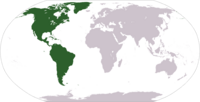 | |
|---|---|---|
| Settlement | ||
| Societies | ||
| Related | ||
| Lists | ||
| Chronology | ||
Template:Link FA Template:Link FA Template:Link FA Template:Link FA Template:Link GA Template:Link GA Template:Link GA Template:Link FA
Categories:- Use dmy dates from August 2012
- Christopher Columbus
- 1451 births
- 1506 deaths
- 15th-century explorers
- 15th-century Roman Catholics
- Age of Discovery
- Apocalypticists
- Burials at Seville Cathedral
- Colonial governors of Santo Domingo
- Columbus family
- Explorers of Central America
- Italian expatriates in Spain
- Italian explorers
- Italian Roman Catholics
- People from Genoa
- Spanish people of Italian descent
- Spanish Roman Catholics